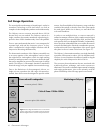
on the floor or solid surface, it can shake as it produces
sound and, consequently, the sound can be compro-
mised. If your speaker is sitting on the carpet and only foot
gliders are used, the bass can be ill defined and even
boomy. The use of spikes is recommended to insure
secured footing for your speakers. (See ‘Solid Footing’ for
spike information and installation instructions).
Dipolar Speakers and Your Room
MartinLogan electrostatic loudspeakers are known as dipolar
radiators. This means that they produce sound from both
their fronts and their backs. Consequently, musical infor-
mation is reflected by the wall behind them and may arrive,
either in or out of step, with the information produced by
the front of the speaker.
In a typical speaker system the low frequencies can either
be enhanced or nulled by the position from the front wall.
Listening to the difference of the bass response as a result
of the changes in distance from the front wall will allow
you to get the best combination of depth of bass and tonal
balance.
Now that you know about reflective surfaces and resonant
objects, you can see how the midrange and high frequencies
can be affected. The timing of the initial wave as it radiates
to your ears, and then the reflected information as it arrives
at your ears later in time, can result in confusion of the
precious timing information that carries the clues to imaging.
Consequently the result is blurred imaging and excessive
brightness. Soft walls, curtains, wall hangings, or sound
dampeners (your dealer can give you good information
here) can be effective if these negative conditions occur.
Solid Footing
After living and experimenting with your Odysseys, you
will then want to implement the enclosed 3/8" x 16 thread
special version ETC (Energy Transfer Coupler) Spikes (See
Figure 6). With the use of these spikes, the Odyssey will
become more firmly planted on the floor and, conse-
quently, bass will tighten and imaging will become more
coherent and detailed. It is best not to implement the
spikes, however, until you are secure in the positioning, as
the spikes can damage the floor if the speaker is moved.
MartinLogan ETC spikes are also available with a common
1/4" x 20 thread insert that may be used on your other
audio equipment (racks, speakers, etc.), which are avail-
able from your local MartinLogan dealer or on our website
at www.martinlogan.com.
Spike Installation Instructions:
1. Carefully lay your speaker on its side to gain access to
the bottom.
2. Remove existing feet or spikes. Thread new spikes into
holes and visually adjust to an equal height.
3. Tighten jam nut snugly by hand. Do not over tighten
the nut.
4. Right the speaker.
Caution: Make sure your hands and any cabling are clear
of the spikes. Do not slide speaker as spikes are sharp and
can damage your floor or carpet.
5. Adjust to level by rotating spikes. Tighten the jam nut
securely when satisfied that speaker is level.
Room Acoustics 11
Figure 6. The ETC Spike.


















